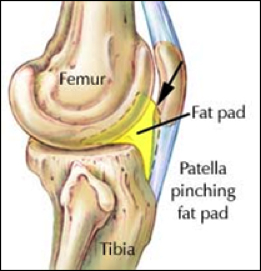The knee is the largest joint in the body, and is one of the more common sources of pain. Anterior knee pain is commonly associated with diagnoses such as patellofemoral joint pain, patellar tendinopathies, bursitis or fat pad impingement.
When you present for treatment for an anterior knee pain, your physiotherapist will first rule out other conditions before confirming a diagnosis of infrapatellar fat pad impingement.
What is a fat pad?
The infrapatellar fat pad is a pad made up of fatty deposits that sits below the patella in the knee. It acts to divide the knee joint in to two chambers. The fat pad looks to keep the patella off the femoral condyle, and acts as a shock absorber to any frontal forces directed towards the patella.
Fat Pad Impingement
On occasion however the fat pad can become pinched between the patella and the femoral condyle resulting in anterior knee pain. This can cause the fat pad to become swollen or inflamed, as the fat pad is a sensitive structure, it can result in pain and discomfort to the front of the knee.
Fat pad impingement is usually due to a direct blow to the knee, a knee hyperextension injury, or a chronic condition caused by a tendency for excessive knee hyperextension in an individual. The bottom tip of the patella is usually responsible for the pinching, or impingement.
Signs and Symptoms of a Fat Pad Impingement Injury
- Having had a hyperextension injury recently
- Pain and swelling around of near the bottom part of the patella
- Pain with knee extension or hyperextension
Differential Diagnosis
The two most common conditions that are confused for fat pad impingement are a patellar tendinopathy, or patellofemoral joint pain. The main point of difference between the tendinopathy and fat pad impingement are that the patellar tendinopathy will cause pain only local to the patellar tendon, particularly at the inferior pole of the patella, whereas fat pad impingement can cause pain on either side of the patellar where the fatty tissue sits.
Also, unlike in the tendinopathy, fat pad impingement pain becomes more pronounced the more the knee is hyperextended. A tendinopathy is usually more painful when a traction force is being applied to the tendon.
Fat pad impingements are also not usually associated with any sounds – i.e. clicking, popping, locking or instability. If you feel you have any of these issues, please consult with your physiotherapist for further investigation.
Treatment for fat pad impingement
Fat pad impingement is ususally treated conservatively – following the principles of RICE to begin with – Rest, Ice, Compression and Elevation. A period without high risk activitym and avoiding a hyperextended position are key to reducing pressure through the fat pad.
If you are diagnosed with fat pad impingement, your physiotherapist will help to first reduce the pain and swelling to the area. Then through in a guided and systematic manner, your physiotherapist will provide you with a strengthening and stretching programme to ensure full recovery. Taping methods can also help alleviate the pressure and can be helpful upon a return to sport.
In some instances, of a more severe case of fat pad impingement, surgery may be required to either fully or partially remove the fat pad. Again however, your physiotherapist will guide you through this decision-making process if required.
So if you have any pain through the front of your knee come in for a consultation at PhysioHealth to get a proper diagnosis and rehabilitation program to suit your needs!
References
Sports Injury Clinic (2014). Fat Pad Impingement. http://www.sportsinjuryclinic.net/sport-injuries/knee-pain/fat-pad-impingement. Accessed: 11th April 2016.
Baylor, Scott and White Health (2015). Hoffa’s Disease. http://www.sw.org/HealthLibrary?page=Hoffa’s%20Disease%20(Infrapatellar%20Fat%20Pad%20Syndrome)%20with%20Rehab-SportsMed. Accessed: 11th April 2016.
HC Chang Orthopaedic Surgery (2016). Hoffa’s Syndrome. http://orthopaedic.com.sg/hoffas-syndrome-fat-pad-impingement-syndrome-a-cause-of-anterior-knee-pain/. Accessed: 11th April 2016.


